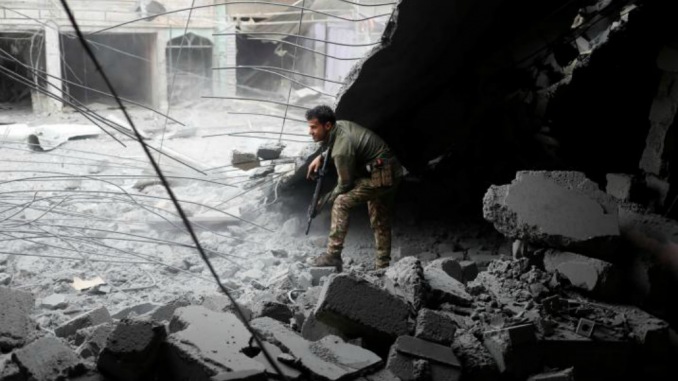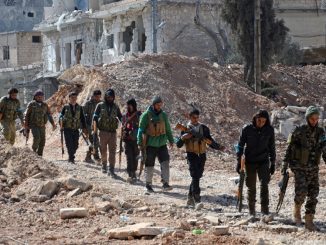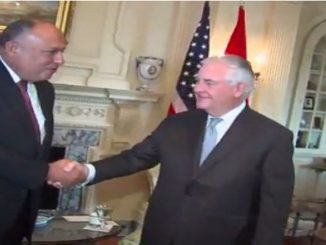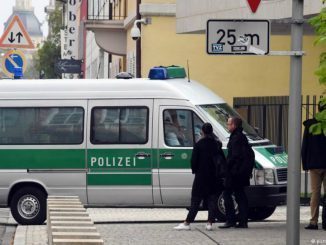
US-backed Iraqi forces advanced amid heavy lashes to edge closer to the al-Nuri mosque in western Mosul on Wednesday, tightening their control over the old city as concerns were raised again over the safety of civilians.
At the height of its power two years ago, Islamic State ruled over millions of people in territory running from northern Syria through towns and villages along the Tigris and Euphrates river valleys to the outskirts of Baghdad in Iraq.
It was the mosque of Mosul where al-Baghdadi declared his Caliphate and named himself as the ruler of all Muslims from Mosul’s Great Mosque after his forces swept through northern Iraq in 2014.
However, ISIS’s territory is shrinking rapidly since last year as the US-led coalition, the Turkish-backed forces, and the Russian-backed Assad regime forces have fierce fights against its forces in both Syria and Iraq.
The United States is providing air and ground support to Iraqi and Kurdish forces trying to dislodge the hardline group from Mosul.
Iraqi forces captured the eastern side of Mosul in January after 100 days of fighting and launched their attack on the districts that lie west of the Tigris river on Feb. 19.
Islamic State militants who retreated across the Tigris river to western districts also regularly target civilian areas under government control in the east with mortars and grenades dropped from drones.
Several thousand militants, including many who travelled from Western countries to join up, are believed to be in Mosul among a remaining civilian population estimated at the start of the offensive at 750,000.
They are using mortars, sniper fire, booby traps, and suicide car bombs to fight the offensive carried out by a 100,000-strong force made up of Iraqi armed forces, regional Kurdish peshmerga fighters and Iranian-trained Shi’ite paramilitary groups.
Advancement towards al-Nuri mosque
The close-quarters fighting is focused on the Old City surrounding the mosque.
Helicopters circling west Mosul strafed ISIS positions beyond the city train station, the site of heavy back-and-forth fighting in recent days, and thick black smoke rose into the sky, Reuters reporters on the ground said.
Heavy sustained gunfire could be heard from the Old City area, where militants are hiding among residents and using the alleyways, traditional family homes and snaking narrow roads to their advantage, fleeing residents say.
“Federal police forces have imposed full control over the Qadheeb al-Ban area and the al-Malab sports stadium in the western wing of Old Mosul and are besieging militants around the al-Nuri mosque,” federal police chief Lieutenant General Raed Shaker Jawdat said in a statement.
Rapid Response elite interior ministry troops were advancing on the edge of the Old City, clambering over garden walls. Islamic State responded with rocket fire, streaking the sky with white smoke plumes.
“There are teams going into the Old City since yesterday,” said Rapid Response official Abd al-Amir.
Iraqi troops shot down at least one suspected ISIS drone. The militants have been using small commercial models to spy and drop munitions on Iraqi military positions.
Civilians at risk after deadly attack
With the battle entering the densely populated areas of western Mosul, civilian casualties are becoming more of a risk. The United Nations says several hundred civilians have been killed in the last month, and residents say ISIS militants are using them as human shields.
Pope Francis said at his weekly audience in St Peter’s Square on Wednesday that it was “urgent and imperative” to protect civilians in Iraq, and he expressed concern about those trapped in western Mosul.
Approximately 230 residents were buried in collapsed buildings in the Iraqi city of Mosul on March 17 after an air strike against Islamic State triggered a massive explosion last week.
Iraqi sources said that airstrikes by the U.S.-led coalition targeting Islamic State militants may have detonated a truck filled with explosives, destroying buildings in a heavily populated area.
Local officials and eyewitnesses say as many as 240 people may have been killed in the Al-Jadida district.
The senior U.S. commander in Iraq acknowledged on Tuesday that the U.S.-led coalition probably had a role in an explosion in Mosul believed to have killed scores of civilians, but said Islamic State could also be to blame.
As investigators probe the March 17 blast, Lieutenant General Stephen Townsend said increases in casualties were to be expected as the war entered its deadliest phase.
250.000 civilians were displaced
As fighting intensified, civilians streamed out of western neighborhoods recaptured by the government,
desperate and hungry and traumatized by living under ISIS’s harsh rule. Some pushed children and sick elderly relatives in handcarts and wheelbarrows.
“We have been trapped for 25 days. No water, no food, everyone will die and they will have to pull us from the rubble,” said one resident of Bab Jdid district, not giving his name because relatives remained inside Mosul.
Families with elderly relatives and children marched through western Mosul’s muddy streets, past buildings pock-marked by bullet and bombs. Some said they had hardly eaten in weeks, scrambling for supplies handed out by a local aid agency.
“It is terrible, Islamic State has destroyed us. There is no food, no bread. There is absolutely nothing,” said another resident.
Soldiers packed them into trucks on the Mosul-Baghdad highway to be taken to processing areas.
As many as 600,000 civilians are caught with the militants inside Mosul, which Iraqi forces have effectively sealed off from the remaining territory that Islamic State controls in Iraq and Syria, while nearly 100,000 Iraqis have fled western Mosul in the past three weeks.
Around 255,000 people have been displaced from Mosul and surrounding areas since October, including more than 100,000 since the latest military campaign in western Mosul began on Feb. 19, according to United Nations figures.
The second week of February has seen the highest level of displacement yet, with 32,000 displaced between March 12 and 15.



